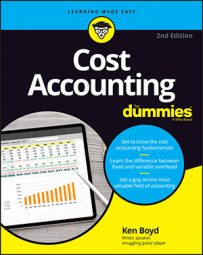In cost accounting, supply chain management (SCM) is a management tool you can use to improve your ordering, manufacturing, and inventory processes. Supply chain management is the technique of analyzing and monitoring the movement of raw materials, work-in-process, and finished goods — from origin to the final consumer.
As you implement SCM, consider how and when your customers order products. After all, customer demand determines when to make something (if you’re a manufacturer) or order something (if you’re a retailer). Customer demand starts the process. SCM helps you make the process more efficient.
Cost accounting of the supply chain
The supply chain is the group of companies that contribute to the flow of goods from a product’s creation to the end customer. Every company in the supply chain can help the overall process. When that happens, you might save money, improve products, or increase sales — all of which are the equivalent of making money. Do an Internet search on “supply chain management” to learn a lot.
When more companies than just your company are involved, as is usually the case, you’re dealing with “the extended enterprise.” It makes sense, because everything affects everything else. Many different people “touch” a product before it reaches the customer.
A principal concept of supply chain management (SCM) is that companies in a supply chain exchange information about fluctuations. The fluctuations include availability, timing, shipping, and seasonal variability.
With supply chain management, you try to manage all activities that affect you. This could include sourcing (materials for manufacturing or finished goods for retailing), production (improving efficiency, eliminating bottlenecks, or increasing capacity), and logistics management (usually shipping, but also inventory management for both manufacturers and retailers).
Cost accounting of customer demand
You no doubt already know that demand varies. The world has uncertainties. Whereas some demand changes are predictable, others may come as a surprise.
You need to get the best handle possible on when customers buy your products and even why they do. That knowledge lets you plan your inventory levels more effectively.
Here are some possible sources of demand variation:
Variable customer demand, seasonal: Demand predictability varies by season. Summer and the holiday season, for example, show predictable increases in customer demand for swimsuits and toys, respectively. You need to stock up before the season.
Variable customer demand, based on a product: You may be surprised at high demand for a single product. For example, envision a retail clothing store that sells jeans — and men’s jeans in certain styles in particular.
Say you notice that men’s prewashed, straight-legged jeans in size 32-34 always sell out. You can’t sell more of what you don’t have. The demand for jeans may be generally predictable, but the demand for a single style/size is a surprise. You need to compensate to take advantage of the popularity of this style/size.
Variable purchasing patterns: There are many products that customers use steadily, maybe every day or week. But for whatever reason, the customers seem to buy the product randomly. So the customer uses the product steadily but doesn’t buy it steadily. Consider giant packages of toilet paper or paper towels.
Variable demand affecting suppliers: A material supplier may have a reduced supply of what you need because of demand from your competitors. Say you were the first to manufacture motorcycle jackets from rip-stop nylon, but now all your competitors are using the material. The material may become less available. You need to compensate by increasing your orders or finding additional suppliers.
When you combine the concepts of supply chain management with your customer demand patterns, you operate more efficiently — and meet the needs of your customers.

